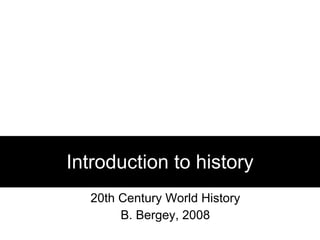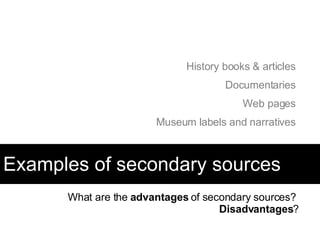Intro To History
- 1. Introduction to history 20th Century World History B. Bergey, 2008
- 4. Objectivity defined the situation implied by the images is a fair and accurate representation of the events they depict in both content and tone. e-wikipedia.net/w/en/Photojournalist A quality in writing characterized by the absence of the author's opinion or feeling about the subject matter. Objectivity is an important factor in criticism. www.novelguide.com / The ability to view something without influence of feelings or emotions. www.brigantine.atlnet.org /
- 5. What is objectivity? Is history objective?
- 6. History as account History as event vs.
- 7. How is history different than other disciplines? Focus & Methodology
- 8. Historical Record Secondary Source: Accounts of the past recorded by someone after the event occurred Primary Sources : Actual records and objects that have survived from the past
- 9. Examples of primary sources Written accounts Photographs/videos Speeches Laws/official documents Newspapers/journals from the day Literature/books Letters/journal entries Interviews, Oral histories Others? What are the advantages of primary sources? Disadvantages
- 10. Examples of secondary sources What are the advantages of secondary sources? Disadvantages ? History books & articles Documentaries Web pages Museum labels and narratives
- 11. Enormous Think of all of the records that are being created presently Historical Record Limited Think of what is not captured in historical records
- 12. Primary or Secondary? Do the following images represent primary or secondary sources?
- 13. Ėý
- 14. Ėý
- 15. Ėý
- 16. Ėý
- 17. Ėý
- 18. Ėý
- 19. Ėý
- 20. Ėý
- 21. Ėý
- 22. Ėý
- 23. Ėý
- 24. Ėý
- 25. Ėý
- 26. Ėý
- 27. Keeping Perspective in Mind
- 28. What affects perspective? Observation Experiment
- 29. What affects perspective? It was six men of Indostan To learning much inclined, Who went to see the Elephant (Though all of them were blind), That each by observation Might satisfy his mind The First approached the Elephant, And happening to fall Against his broad and sturdy side, At once began to bawl: "God bless me! but the Elephant Is very like a wall!" Six Blind Men and the Elephant by John Godfrey Saxe
- 30. What affects perspective? The Second, feeling of the tusk, Cried, "Ho! what have we here So very round and smooth and sharp? To me 'tis mighty clear This wonder of an Elephant Is very like a spear!" The Third approached the animal, And happening to take The squirming trunk within his hands, Thus boldly up and spake: "I see," quoth he, "the Elephant Is very like a snake!" Six Blind Men and the Elephant by John Godfrey Saxe
- 31. What affects perspective? The Fourth reached out an eager hand, And felt about the knee. "What most this wondrous beast is like Is mighty plain," quoth he; " 'Tis clear enough the Elephant Is very like a tree!" The Fifth, who chanced to touch the ear, Said: "E'en the blindest man Can tell what this resembles most; Deny the fact who can This marvel of an Elephant Is very like a fan!" Six Blind Men and the Elephant by John Godfrey Saxe
- 32. What affects perspective? The Sixth no sooner had begun About the beast to grope, Than, seizing on the swinging tail That fell within his scope, "I see," quoth he, "the Elephant Is very like a rope!" And so these men of Indostan Disputed loud and long, Each in his own opinion Exceeding stiff and strong, Though each was partly in the right, And all were in the wrong! Six Blind Men and the Elephant by John Godfrey Saxe
- 33. What affects perspective? Six Blind Men and the Elephant by John Godfrey Saxe Moral: So oft in theologic wars, The disputants, I ween, Rail on in utter ignorance Of what each other mean, And prate about an Elephant Not one of them has seen!
- 34. What affects perspective? The changing color card trick http:// pastimperfect.wordpress.com /
- 35. Perception is affected by Who the author is, including the values of the author. What the purpose is. What information is used to draw conclusions. Who the audience is. When it is being written.
- 36. Historiography The study of the how historical accounts of the same events change over time. Consider: Why do history textbooks need to be up-dated every five to seven years?



































